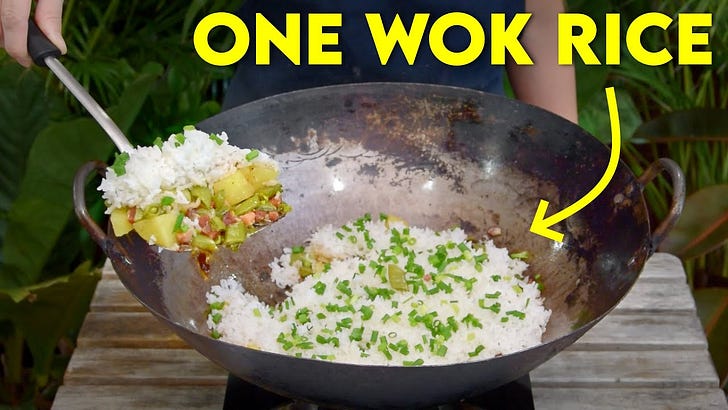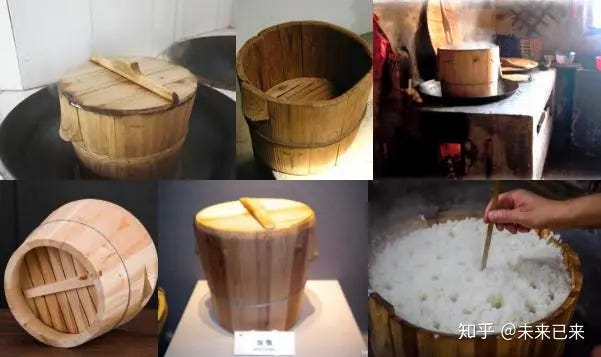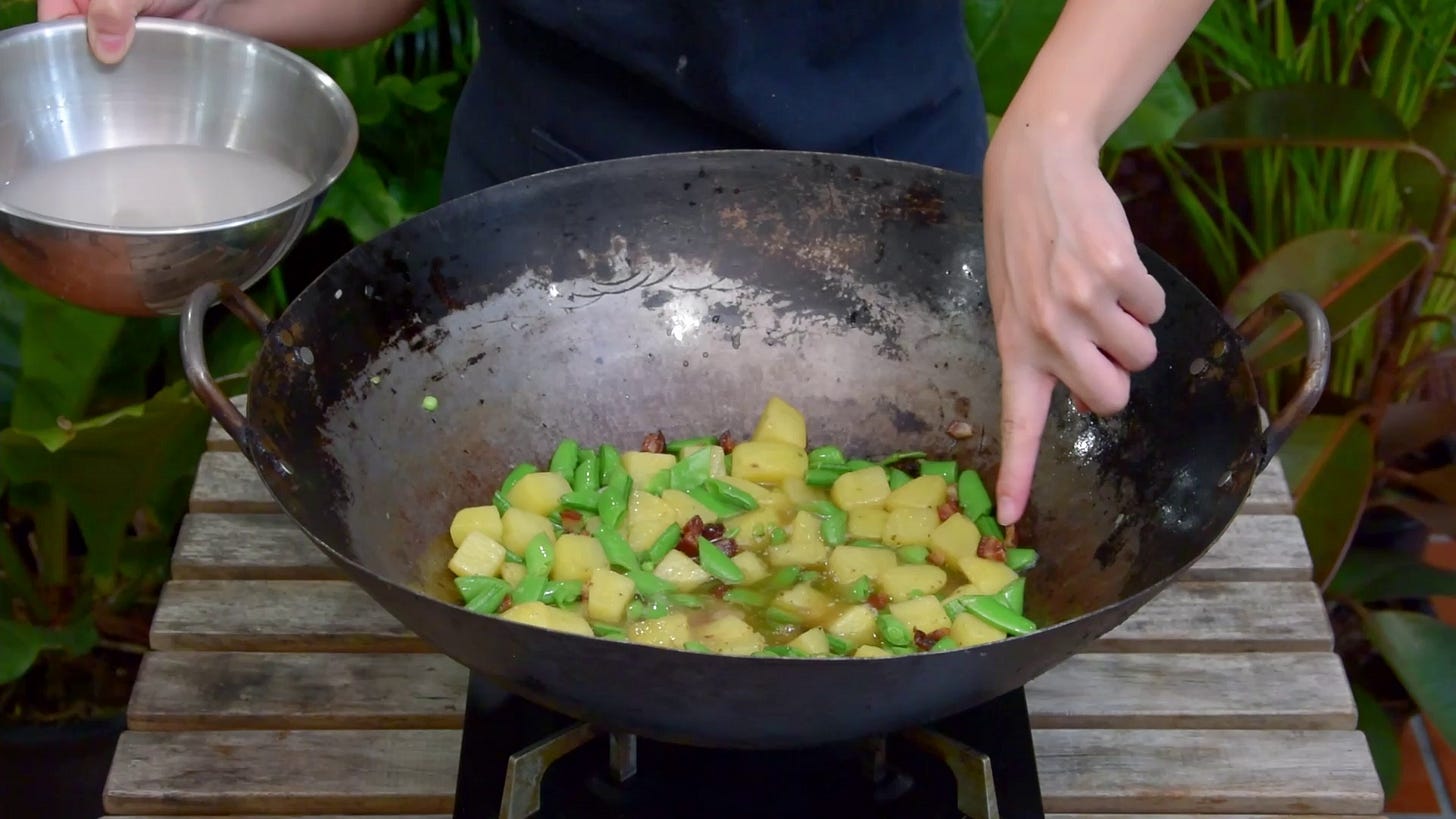Sichuan Kongfan, a Chinese Pilaf - sort of (箜饭)
Why doesn't Chinese rice tend to employ the Pilaf method, and are there any that actually do?
One of the most popular methods to cook rice throughout the rice-loving world is the pilaf method. From the Plovs in Central Asia, to the Biryanis in the Indian subcontinent, to Kabsa on the Arabian peninsula, to Paella, to Jambalaya… all of these beloved rice dishes tend to use the following approach, or some sort of close variation thereof:
Fry up a base with aromatics
Add rice, sautee with the aromatics
Add enough water to barely cover the rice
Cook the rice in the flavorful liquid
So… why doesn’t China do the same? Why is it that in China, rice is so often served plain and white, forgoing this approach that seems so enduring and popular elsewhere in the world?
Well, there is definitely the fact that many Chinese cuisines tend to use plain white rice as a ‘canvas’ of sorts for other, flavorful dishes. Just like how someone in the West might not want their hamburger bun to be loaded with nuts, herbs, or fruit… white rice can often just plain go better with highly flavorful stuff like Mapo Tofu or Shuizhu Beef.
But there’s also another, more straightforward answer to why the Pilaf method didn’t quite take off in China – it just plain doesn’t work with Chinese rice.
Why Chinese Rice Doesn’t Play well with the Pilaf Method
See, the two dominant rice varietals in China are (1) Zhanmi (粘米), i.e. Champa Rice and (2) Jingmi (粳米). Broadly speaking, the former is more popular in the south, and acts and behaves quite similar to Jasmine Rice. The latter is more popular in the North, and is quite similar to what’s referred to as Calrose in the United States.
With either varietal (and Jasmine and Calrose for that matter), using the pilaf method can be finicky at best. Rices like Basmati or Bomba are fantastically easy to work with – you don’t need to worry too much about overshooting or undershooting the liquid quantity when cooking, a rough ballpark is fine.
But if you blindly charged forward with, say, a Kabsa using Chinese rice, you’re going to have a bad time – as all my pathetic attempts at Jambalaya using Champa or Jasmine rice can attest. It’s the same reason why Xinjiang restaurants outside of Xinjiang can often struggle with their Polo (i.e. 手抓饭 or “Hand Grasping Rice”) – a dish that does follow that Pilaf method. There’s a specific variety of rice within Xinjiang that’s much closer to something like an Uzbek Laser rice (新疆米, it’s an awesome rice as an aside), and subbing that on the coast can be a bit of challenge.
But that doesn’t mean that China doesn’t like to flavor its rice sometimes, clearly. There’s just different approaches. One obvious approach would be to make fried rice, as I’m sure everyone here is intricately familiar with. There are also dishes like Toishanese youfan (油饭), which finish and functionally mix the rice with a pre-prepared stir fry. And of course you could also keep the flavor in liquid or oil form, ala Zhanjiang Duck rice or Hainan Chicken rice.
But none of these dishes quite hit that same spot as the pilaf method, I think? The cool thing about the Pilaf method is it not only flavors the rice, but that you can load up the rice up with a metric shit ton of add ins. Like, some Paellas I see out there seem to practically as much ‘stuff’ as it is rice.
But there is one approach that I think can scratch that itch…
Sichuanese Kongfan
The basic logic of this dish is to use the boil-and-steam method of cooking rice. We’ve waxed poetic about this technique of cooking rice before, as (1) it’s almost as fool proof as a rice cooker and (2) it makes phenomenal rice for fried rice (that you don’t need to wait a day to dry out). The technique goes:
Par Boil Rice. Literally, just boil the rice as if it was pasta. Go until it loses its translucency, ~3 minutes.
Transfer to a Steamer. Line a bamboo steamer with a wet cloth and dump the rice in.
Steam for 15 minutes.
Of course, both the rice cooker and the basic “water up to the first knuckle and boil” method are definitely less steps. Usually you see this approach in the countryside where people are making a *lot* of rice, often in one of these cool big buckets:
This dish is the same idea, albeit without a steamer. Basically, what you’ll do is make some sort of stir-fry – classically something with some chunky root vegetables inside – and then layer the par-boiled rice on top of the stir fry. “Lifting” the rice in this way allows the rice to steam – without a steamer.
Ingredients
Jasmine rice (粘米/泰国香米), 250g.
Smoked Larou (烟熏腊肉/四川腊肉) -or- Pancetta -or- Country Ham, 80g. Basically some sort of cured meat, preferably a smokey one. Note that Cantonese Larou (Lap Yuk) is seasoned quite differently – the aforementioned substitutes are closer in flavor.
Green beans (四季豆), 250g. Strings peeled, if needed.
Potato, 500g. Something starchy like Russets or Yukon Gold (the default Chinese potatoes are Russets).
Scallions, ~2 sprigs.
Oil for frying, lard preferably, 3 tbsp. If you’re using Pancetta (which’s less hard and renders out more oil), you will likely only need ~1 tbsp.
Seasoning:
Salt, 1 tsp
Five Spice Powder (五香粉), ¼ tsp
White pepper powder (白胡椒粉), ¼ tsp.Water for steaming. Enough to reach ‘halfway’ up your ingredients
Process:
Rinse the rice 2-3 times, then boil it (like it’s pasta) for three minutes. Strain, and set aside. If you like, reserve the rice cooking liquid – more on that in the note below.
Cut the Larou (or your cured pork product of choice) into ½ cm cubes. Cut the green beans on a bias into ~1.5 inch sections. Cut the potato into ~1 inch chunks. Separate the white part of the scallion from the green part and slice both. The former will be fried as an aromatic and the latter will finish the dish.
To a wok, first longyau: get it piping hot, shut off the heat, add in the oil, and give it a swirl to get a nice nonstick surface. Add in the Larou at first, fry it over a medium-low flame until it releases a bit of its lard and turns golden brown, ~5 minutes. This is what you’re looking for for Pancetta, and this for Larou:


Add in the scallions, fry for ~30 seconds until fragrant. Then add in the potatoes and stir fry for ~3 minutes, or until the edges of the potatoes are beginning to get translucent, like so:
Add in the green beans. Continue to fry for ~90 seconds, or until the beans begin to deepen in color. Add in the seasoning and mix. Add in the water until it’s about halfway up the potato, like so:
Layer the rice on, then poke a couple holes in the rice with a chopstick so steam can go through, then cover. Cook for 14 minutes.
After that time, you’ll know it’s done primarily by its sound – it should sound like it’s starting to ‘fry and sizzle’ instead of ‘boil and bubble’, like so:
At this point, the rice is done, but you can continue to fry the rice to get a bit of a crust if you like. To do so, up the flame to medium, and tilt the side of the wok into the flame to get the edges, moving it around every minute or so. The extent of this frying is ultimately up to you – we did this step for about ten to fifteen minutes to get some light browning, but you could alternatively skip it, or go longer to get something closer to guoba/socarrat.
Uncover, sprinkle over the scallion greens, and serve.
Note on the Rice Boiling Liquid:
The rice boiling liquid is traditionally served alongside the meal as a ‘soup’ of sorts. It’s called “米汤” and thought to be quite nutritious, though the practice likely stems from times when there wasn’t enough rice to eat.
Either way, it is definitely pretty soothing – especially in the winter. I’d definitely suggest saving it and giving it a whirl to see if you enjoy it at least. In the video, we used the rice boiling liquid as the ‘water for steaming’ sort of on a whim – you could go that route or not, up to you.






